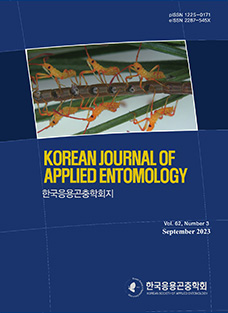Currently, approximately 460 aphid species have been documented in the Korean Peninsula (Lee et al., 2014). This figure is notably lower than the aphid species richness reported in neighboring countries, approximately 750 and 1,100 species documented in Japan and China, respectively (Blackman and Eastop, 2024;Liu et al., 2009;Miyazaki et al., 2016). Given this discrepancy, it is reasonable to anticipate that continued taxonomic investigations will likely reveal additional unrecorded species in the Korean Peninsula, potentially narrowing this gap in documented aphid diversity. The number of documented species is continuously increasing, due to not only ongoing research efforts but also significantly biological invasions. Consequently, the importance of carefully monitoring invasive species has become increasingly highlighted.
Aulacophoroides is a small genus native to East Asia, with four known species (Favret, 2024). These four aphid species are known to inhabit and feed on woody, vine-like leguminous plants as their hosts (Blackman and Eastop, 2024). A comprehensive review of this genus was conducted by Qiao et al. (2006). However, research in Korea has been limited since Szelegiewicz (1979) described A. virgatae from North Korea, with no significant studies conducted thereafter. Recently, we identified the dark-red wisteria aphid, Aulacophoroides hoffmanni (Takahashi, 1937), inhabiting Wisteria floribunda (Willdenow) (Fabaceae) in the western region of South Korea, for the first time. This species, originally described in China, is a monoecious aphid that specifically inhabits W. sinensis (Sims) (Blackman and Eastop, 2024).
Wisteria spp. are woody vines cultivated worldwide for their ornamental value, with W. floribunda being particularly popular due to its numerous cultivars. In Korea, Wisteria is widely distributed throughout the country and extensively cultivated in diverse public settings, including botanical gardens, urban parks, and educational institutions (Kim, 2012). At the time of field collection, this species was undergoing a severe outbreak, extensively colonizing the entire wisteria plant (Fig. 1A-C). Due to the copious honeydew secretion by the aphids, we easily observed that the plant surfaces had developed sooty mold, turning them black, and the overall plant vigor had weakened, resulting in visible growth inhibition (Fig. 1A-B). The discovery of A. hoffmanni on W. floribunda in South Korea and its observed severe infestation suggest that this aphid species could potentially become a significant pest of ornamental wisteria.
Our recent investigations have led to the first record of A. hoffmanni in South Korea. This study presents a comprehensive documentation of A. hoffmanni, including detailed morphological descriptions, precise measurements, high-quality photographic evidence of live specimens, and microscopic images of slide-mounted individuals.
Materials and Methods
Aphid specimens were collected in 2024 from two locations in western South Korea: Taean and Gunsan. Live aphids were photographed using a Canon EOS 70D camera (600 dpi resolution) before being preserved in 90-95% ethanol and stored for more than one month. Slide-mounted specimens were prepared using Canada balsam, following the methodologies described by Blackman and Eastop (2000) and Martin (1983). Microscopic images were captured using a Leica DM2500 microscope equipped with an ICC50 E camera and Leica Application Suite 4.11.0 (Leica, Germany). Morphometric analyses were conducted using Mosaic V2.3 (Tucsen Software) and Helicon- Focus 7 (Helicon Soft) software. All specimens examined in this study have been deposited in the entomological collection of Kunsan National University, Republic of Korea (KSNU).
Abbreviations used for description, figures, and Table 1 are: BL, Body length; ANT, antennae; ANT I-VI, antennal segments I-VI; BASE, basal part of last antennal segment; PT, processus terminalis of last antennal segment; Ls ANT III, longest setae on ANT III; BD III, basal diameter of ANT III; URS, ultimate rostral segment; FEM, hind femur; TIB, hind tibiae; HT 2, second segment of hind tarsus; SIPH, siphunculus; ABD TERG I-VIII, abdominal tergites I-VIII.
Taxonomy
Aulacophoroides Tao, 1976 좀싸리진딧물속
Type species. Aulacophoroides formosana (Takahashi, 1923) 등나무수염진딧물(신칭)
Material examined. 10 apterous viviparous females, 187, Cheollipo 1-gil, Sowon-myeon, Taean-gun, Chungcheongnam -do, Republic of Korea, 15N, 126°15'00''E, on Wisteris floribunda, Y. Lee & H. Lee Leg., 26.vi.2024, no. 240626YR-1; 10 apterous viviparous females, 558, Daehak-ro, Gunsan-si, Jeonbuk-do, Republic of Korea, 35°56'35"N, 126°40'50"E, on Wisteris floribunda, H. Namgung Leg., 03.vii.2024, no. 240703HB.
Descriptions. Apterous viviparous female:
Color in life (Fig. 1D-E). Head reddish brown, compound eye red. ANT I-II, VI mostly black, ANT III-V black with occasional bright spots. Thorax reddish brown. ABD TERG reddish brown with dark transverse bands, lateral sides of abdomen with dark scattered spots. Coxae concolorous with body, femora black, tibiae pale brown, tibial apex and tarsi black. SIPH black. Cauda pale.
Morphology (Fig. 2; Table 1). Body oval, BL 2.51-3.38mm long. Head with three pairs of anterior and four pairs of posterior pointed hairs about 0.05-0.07 mm long, head with densely spinulose band, median frontal tubercle absent, median protrusion on frons developed, antennal tubercles well developed. ANT 6-segmented, 2.65-3.44 mm long, ANT 0.86-1.11 × BL, ANT I with small imbricated spot, ANT I-II, distal part of ANT III bearing dense band of spinules, ANT III-ANT VI with sparse spinules, inner margins of ANT I diverging, ANT III longest with 3-4 small rounded secondary rhinaria in a row on the basal 1/3 of the segment. Ls ANT III 0.80-1.25 × BD III, ANT IV without secondary rhinaria, slightly longer than ANT V, ANT VI imbricated, PT 5.07-6.75 × BASE. Rostrum reaching to hind coxae, URS elongate with blunt apex, 0.15-0.19 mm with 5-6 accessory setae, URS 2.11-2.67 × BASE, 1.14-1.58 × HT 2. Thorax, Dorsal ABD TERG I-VIII covered with spinulose bands, with moderate number of setae, dorsal hairs pointed, abdominal margin with papilliform papilla-like tubercle. Coxae with dense spinular band, femora with sparse spinules, setae on tibiae slightly shorter than the antennal hairs, acute at apices, longest setae on TIB 1.00-1.60 × middle width of TIB, first tarsal segment with 4-5 setae, HT 2 0.12-0.15 mm long. First tarsal chaetotaxy 3, 3, 3. SIPH cylindrical without swollen part, with distal flange, 0.65-0.78 mm long, 0.20-0.26 times as long as BL, 1.81-2.78 times as long as cauda, 4.6-6.00 times as long as its own basal width. Cauda rounded elongatetriangular with 11-16 hairs, 0.27-0.36 mm long, 1.50-1.88 times as long as its basal width. Anal plate with spinulose band.
Distribution. China (Zhejiang, Hangzhou, Shandong) and South Korea (Gunsan, Taean)
Host plant. Wisteria sinensis in China, W. floribunda in South Korea.
Remarks. A. hoffmanni differs morphologically from Aulacophoroides virgataeSzelegiewicz, 1979 as follow: A. virgatae exhibits a distinctive glossy green coloration in life and is characterized by an elongate-cylindrical cauda form that tapers apically, with similarly elongate-cylindrical SIPH that taper towards the apex.
Key to species of Aulacophoroides in Korea (apterous viviparous females)
-
1. Body characterized by extremely short, blunt setae on antennae and dorsum (< 0.33 × BD III); cauda elongate (0.78× SIPH); URS short (0.78× HT 2), with 2 accessory setae ······································· A. virgatae Szelegiewicz
-
- Antennal and dorsal setae notably elongate, pointed (0.80 - 1.25 × BD III); cauda distinctly short (0.36-0.55× SIPH); ultimate rostral segment elongate (1.14-1.58 × HT 2), with 5-7 accessory setae ··················· A. hoffmanni (Takahashi)
Discussion
The discovery of Aulacophoroides hoffmanni in western South Korea represents the first record of this species outside its previously known distribution in southeastern China. Notably, while this aphid was originally described from Wisteria sinensis in China, our observations document its presence on W. floribunda in Korea, indicating potential host plant utilization across different Wisteria species. The pathway of introduction remains uncertain, though its detection in western South Korea is noteworthy given the species' known distribution in southeastern China.
The establishment of A. hoffmanni in Korea raises significant concerns for Wisteria cultivation. Our observations revealed severe infestations characterized by extensive feeding damage, abundant sooty mold accumulation, and marked inhibition of new leaf growth. While Aphis fabae has been occasionally recorded on Wisteria in Korea, no significant aphid outbreaks have been previously documented on this host plant. The year-round monophagous life cycle of A. hoffmanni on Wisteria suggests potential for sustained pest pressure on these economically important ornamental plants.
Given the substantial horticultural significance of Wisteria in Korea and globally, further monitoring of A. hoffmanni in Korea is crucial. Future research should focus on understanding its current distribution within the country and developing effective management strategies to mitigate potential economic impacts on Wisteria cultivation. Implementation of monitoring and control measures is recommended to better understand its spread and minimize damage to Wisteria plantings.









 KSAE
KSAE





